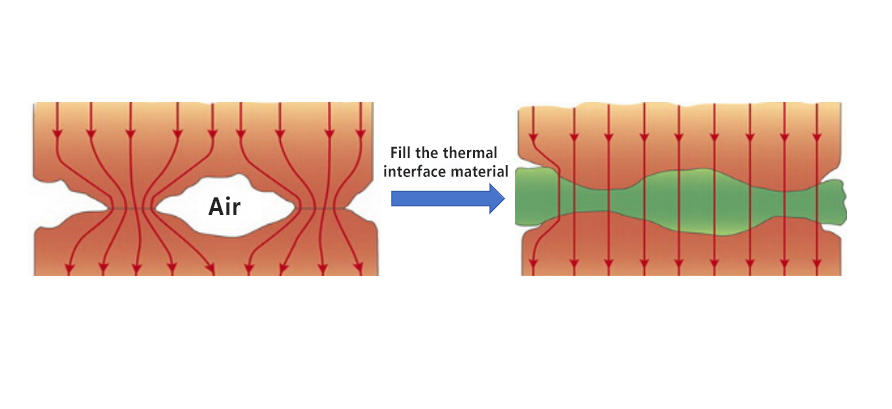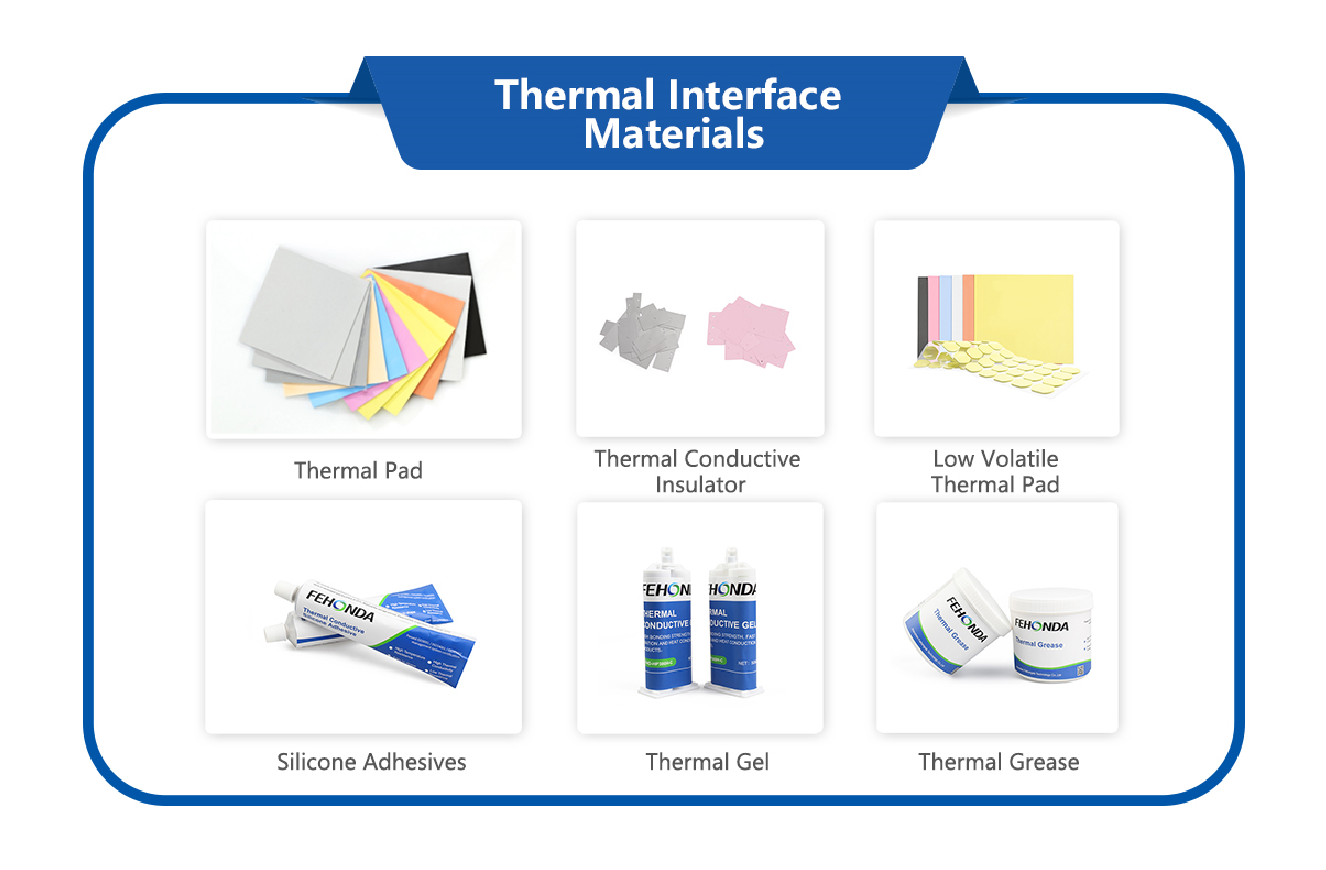Thermal interface materials (TIMs) are materials that fill the gap between the heat source and the heat dissipation device. These materials are used to fill the small voids and surface irregularities that occur during bonding or contact, reducing thermal contact resistance and improving the heat dissipation performance of the device.
The uniform thermal conductivity of components along two directions of their material surfaces is usually limited. Therefore, materials with high thermal conductivity in the horizontal direction are required to spread localized high temperatures outward. Additionally, between different components, the direct contact between the interfaces often has irregular gaps, which create thermal resistance (since the thermal conductivity of air is very low). Hence, thermal interface materials are needed to fill these gaps, allowing heat to transfer more efficiently between different interfaces.

The heat dissipation principle of thermal interface materials
Thermal conductive materials come in a wide variety, with different characteristics and application scenarios. The thermal conductive materials independently developed and produced by Feihongda include: thermal pads, thermal gels, thermal grease, thermal conductive insulator, phase change materials, thermal silicone rubber, thermal potting glue, and thermal double-sided tapes. The following will introduce how thermal conductive materials contribute to technological development and industrial upgrading.

The AI computing power gap accelerates the construction of data centers, which will drive demand for thermal conductive materials
With the rapid development of AI applications, there is an increasing demand for higher AI chip computing power. Manufacturers are stacking a large number of chips as close together as possible to ensure fast information transmission between chips. However, the operation of data centers generates significant heat, and efficient cooling systems are essential to ensure proper functioning. As AI and other fields continue to evolve, they will continuously stimulate the growth of data volumes, thus driving the construction of data centers. Therefore, we expect that the number of new data centers will maintain double-digit growth in the coming years. The corresponding market size for thermal conductive materials for data centers is projected to be 550 million yuan in 2024 and 710 million yuan in 2025.

The data source: 2023 Thermal Materials Industry Research Report
The continuous construction of 5G base stations will bring sustained demand for thermal conductive materials
Currently, China is advancing rapidly in 5G construction and is leading globally. According to the Ministry of Industry and Information Technology's (MIIT) "14th Five-Year Plan for Information and Communication Industry Development" and the "Telecommunication Industry Statistical Bulletin," in 2022, the number of 5G base stations per 10,000 people was 16.4. This falls short of the 2025 target of 26 base stations per 10,000 people. Therefore, it is expected that a large number of additional 5G base stations will be built in the future, which will also drive the demand for thermal conductive materials. According to the MIIT's "Telecommunication Industry Statistical Bulletin," which discloses the annual number of new base stations in China and mentions that about 60% of global 5G base stations are located in China, we predict that the global number of 5G base stations will reach 2.13 million and 2.23 million in 2024 and 2025, respectively. According to a survey by Taiwan's Electrical and Electronic Industry Association, the value of thermal conductive materials for 5G base stations is approximately 2,000 yuan per station. This corresponds to a global market size of 4.3 billion and 4.5 billion yuan for 5G base station thermal conductive materials in 2024 and 2025.

The data source: 2023 Thermal Materials Industry Research Report
The technological iteration and performance improvements in consumer electronics are driving the rise in thermal conductive materials prices
The penetration rate of 5G in the smartphone market is approaching 50%, and the growth rate of this penetration is expected to slow down gradually. It is estimated that by 2024-2025, the penetration rate of 5G smartphones will be 59.4% and 64.4%, respectively. 5G smartphones will generate more heat, increasing the demand for more advanced thermal management solutions, thus driving the rising value of thermal conductive materials required per unit. The penetration of high-end thermal conductive materials, such as graphene films and vapor chambers (VC), in smartphones is expected to continue to rise. We assume that the penetration rates for VC and graphene films will be 30%/35% and 15%/20%, respectively. The penetration rate of VC in PCs will be 3.0%/4.0%. Additionally, as the thermal management materials, such as heat pipes and graphene, mature, the average value per unit is expected to gradually decline. Taking all factors into account, it is predicted that the market size for thermal conductive materials in consumer electronics will reach 14.3 billion and 15.2 billion yuan in 2024-2025.

The data source: 2023 Thermal Materials Industry Research Report
The increasing penetration of new energy vehicles is driving the growth of the thermal conductive materials market
According to CITIC Securities Research Department's series of reports on the new energy vehicle industry and electric drive systems, titled "Focusing on the 300 Billion Market: Technological Iteration Drives Cost Reduction and Efficiency Improvement", the global penetration rate of new energy vehicles is expected to be 20.7% in 2024 and 24.7% in 2025. Since the thermal conductive materials used in new energy vehicles have a higher value than those in traditional fuel vehicles, the rising penetration rate of new energy vehicles will drive an increase in the demand for thermal conductive materials. Based on this, the market size for automotive thermal conductive materials is expected to reach 5.5 billion and 6.4 billion yuan, respectively.

The data source: 2023 Thermal Materials Industry Research Report
According to various industry report studies, the global thermal conductive materials market is predicted to reach 36.1 billion yuan by 2030. In an era of rapid technological development, thermal conductive materials, as a key component in the heat dissipation field of electronic devices, empower technological advancements and support industrial upgrades. Feihongda focuses on continuous research and innovation, with the goal of launching more high-performance, environmentally friendly, and multifunctional thermal conductive materials in the future to bring greater convenience and innovation to various industries.





